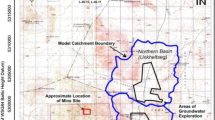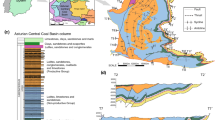Abstract
Some of the world’s deepest goldmines operate below dolomitic karst aquifers in the Far West Rand (FWR) goldfield, South Africa. Associated impacts include the continuous dewatering of karst aquifers for over six decades and irreversible changes of the hydrogeological setting. Affecting an area of approximately 400 km2 by drawing down the water table up to 700 m, these impacts, and the large amounts of data generated in the process, are used as unique research opportunities to better understand the complex karst hydrology. The focus of this study is on predicting final water table elevations in rewatered aquifers after mining ceases taking the fact that mines hydraulically linked previously disconnected aquifers into account. While part 1 of this series develops the conceptual model, this second part utilises large sets of pertinent data to calculate actual flow rates for predicting the fate of dried up springs after mine closure. Following a Darcy-based approach first applied by Swart et al. (Environ Geol 44:751–770, 2003a) it is not only predicted that the springs will flow again but also shown that linear relationships exist between flow rates through a combined system of karst-fractured aquifers overlying the mine void and the associated hydraulic head driving them. This suggests that—at this scale—porous media-based equations can be meaningfully used to predict flow in non-porous media.











Similar content being viewed by others
Notes
Simplified expression of the term \(\frac{l}{k*A}\) whereas l = flow path length of through-flow media, k = hydraulic conductivity (m/s), A = cross-sectional area of flow path (m²).
The approach used to derive values for the flow resistance (Eq. 2) hypothetically assumes a plane drawdown of the water table over the whole horizontal extent of the compartment, which is caused by exclusively vertical groundwater flow between the dolomitic aquifer and the mine void. Therefore, the approach is virtually equal to a laboratory falling head setting, which is a general method used to determine the hydraulic conductivity/transmissivity of soil in the laboratory [e.g. described in Todd (1959)]. Actually during drawdown in the study area (steep) depression cones formed above the mine void and horizontal groundwater flow transported water towards the centre of the depression cone. This would be in contradiction to the theoretical basis of the approach. However, it is assumed that near the centre of depression cone vertical flow dominated and that water level measurements from those areas can be used in the above (falling head) approach.
The used data is a selection of a much larger compilation of data that were compiled electronically after converting them from a variety of original formats including hand-drawn diagrams, data sheets, maps and unpublished reports that were scattered over a multitude of sources including private collections, archives, mining companies, governmental departments and academic institutions. The data were collected and compiled over decades by Professor E.J. Stoch (Mine Water Re-search Group, North-West University, South Africa), who prevented many of them from being irretrievably lost.
Scatterplots include the inrush volume of some 386 Ml/d observed during an accidental inrush event in October/November 1968 (described in Cartwright (1969) that appeared under the hydraulic head of a completely filled-up compartment.
Example for the calculation of the IGF through the Venterspost Dyke: \(IGF = \frac{37 m}{{614 s/m^{2} + 2470 s/m}} = 0.01\frac{{m^{3}}}{s} = 1.04 Ml/d\).
References
Cartwright AT (1969) West Driefontein—ordeal by water. J.G. Ince & Son Pty Ltd, Gold Fields of South Africa
Cousens RRM, Garrett WS (1969) The flooding at the West Driefontein mine. South Afr Inst Min Metall 69:421–463
de Kock WP (1964) The geology and economic significance of the West Wits Line. The Geology of some ore deposits in Southern Africa. Geol Soc S Afr, Johannesburg, pp 323–386
Jordaan JM, Enslin JF, Kriel J, Havemann A, Kent LE, Cable WH (1960) Final report of the Interdepartmental Committee on Dolomitic Mine Water: Far West Rand. Department of Water Affairs and Forestry, Pretoria
Schrader A, Winde F, Erasmus E (2014) Using impacts of deep level mining to research karst hydrology—a Darcy-based approach to predict the future of dried-up dolomitic springs in the Far West Rand goldfield (South Africa). Part 1: A conceptual model of recharge and inter-compartmental flow. Environ Earth Sci. doi:10.1007/s12665-014-3263-0
Swart CJU, James AR, Kleywegt RJ, Stoch EJ (2003a) The future of the dolomitic springs after mine closure on the Far West Rand, Gauteng, RSA. Environ Geol 44:751–770
Swart CJU, Stoch EJ, van Jaarsveld CF, Brink ABA (2003b) The lower Wonderfontein Spruit: an exposé. Environ Geol 43:635–653
Todd DK (1959) Ground water hydrology. Wiley, New York
Usher BH, Scott R (2001) Post mining impacts of gold mining on the West Rand and West Wits Line, Chapter 5. In: Hodgson FDI, Usher BH, Scott R, Zeelie S, Cruywagen LM, de Necker E (ed) Prediction techniques and preventative measures relating to the post-operational impact of underground mines on the quality and quantity of groundwater resources. WRC Report No. 699/1/01. Water Research Commission, Pretoria, pp 5.1–5.117
Winde F, Stoch EJ, Erasmus E (2006) Identification and Quantification of Water Ingress into Mine Voids of the West Rand and Far West Rand Goldfields (Witwatersrand basin) with a View to Long-Term Sustainable Reduction thereof. Final report, Project No. 5512, Council for Geoscience, Pretoria
Wolmarans JF (1982) The least unsafe route, vol 1. Webb and Partners, Carletonville
Acknowledgments
The authors gratefully acknowledge the support of Prof. E.J. Stoch, who contributed to the used collection of unique historical data. The authors wish to thank Mrs. Heather Erasmus for editing as well as the National Research Foundation (NRF) for the financial support that allowed presenting the findings of the research project on two international conferences (grant number 86331).
Author information
Authors and Affiliations
Corresponding author
Rights and permissions
About this article
Cite this article
Schrader, A., Winde, F. & Erasmus, E. Using impacts of deep-level mining to research karst hydrology—a Darcy-based approach to predict the future of dried-up dolomitic springs in the Far West Rand goldfield (South Africa). Part 2: predicting inter-compartmental flow and final groundwater tables. Environ Earth Sci 72, 2583–2595 (2014). https://doi.org/10.1007/s12665-014-3298-2
Received:
Accepted:
Published:
Issue Date:
DOI: https://doi.org/10.1007/s12665-014-3298-2




